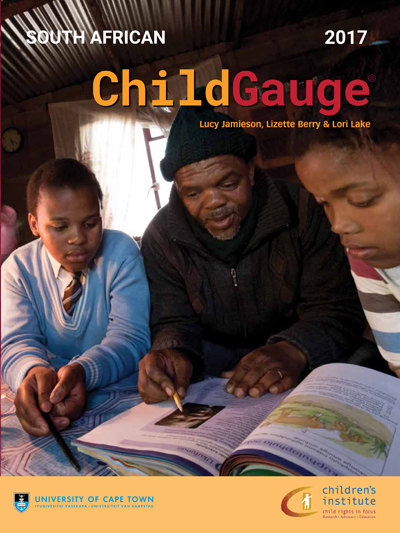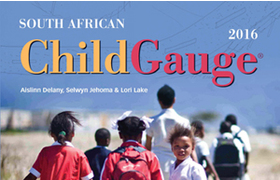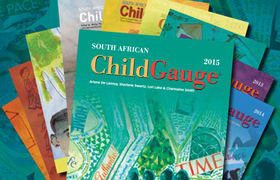Invest in children for sustainable development
28 November 2017 | Story Supplied. Photo Supplied.
Most of South Africa’s children are surviving, but too many are failing to achieve their full potential, which is costing the economy billions. Investing in children – particularly in violence prevention, networks of care, nutrition, education and inclusive services – would drive the next wave of social and economic transformation, boost gross domestic product, and secure a more sustainable future for everyone.
The South African Child Gauge 2017, which was released today, explores what the country’s children need to thrive. Since 1994, child poverty has decreased and children’s survival and access to basic services has improved, but these changes are not enough to unlock the full potential of all children. Violence, poverty, hunger and poor-quality education continue to compromise children’s development and life chances – with a negative impact on the country’s development.
This 12th annual review of the situation of the country’s children has been published by the Children’s Institute (CI), University of Cape Town, in partnership with UNICEF South Africa; the DG Murray Trust; the DST-NRF Centre for Excellence in Human Development, University of the Witwatersrand; The Standard Bank Tutuwa Community Foundation; and the Programme to Support Pro-poor Policy Development in the Department of Planning, Monitoring and Evaluation.
The theme of the 2017 issue – Survive, Thrive, Transform – echoes the Global Strategy for Women’s, Children’s and Adolescents’ Health, which aims to end preventable deaths, ensure health and well-being, and expand enabling environments in line with the United Nations’ sustainable development goals (SDGs).
Adopted by South Africa and other member states in 2015, the SDGs set an ambitious agenda: “They call for a coordinated global effort to transform societies, economies and the environment to ensure a fairer and safer future for all – and a new approach to human development, starting with the most vulnerable to ensure that no one is left behind,” says Hervé Ludovic de Lys, UNICEF South Africa Country Representative.
Lucy Jamieson, CI Senior Researcher and lead editor of the South African Child Gauge 2017, explains: “While the SDGs are a global agenda, their vision of intersectoral collaboration and inclusive development can help take South Africa forward – provided we start by investing in children.”
What will it take for children to thrive?
“Children’s ability to thrive”, explains David Harrison, CEO of the DG Murray Trust, “is rooted in their ability to learn, their motivation to succeed, and in healthy relationships that protect them from adversity.”
Nurturing young children’s capabilities, says Harrison, can increase employment; promote economic growth; and create a safer, happier society: “If we nurture all children’s normal growth and development – from conception to adulthood – we will unlock that human potential, disrupt intergenerational cycles of poverty and drive down inequality.”
A recent study found that violence against children cost South Africa an estimated R239 billion – or 6% of the GDP – in 2015. In addition, stunting – a sign of chronic malnutrition that affects one in four children under five in the country – compromises children’s education, long-term health and employment prospects, and costs the country an estimated R62 billion per year.
All children thrive under the right conditions, and there are a range of opportunities to promote optimal development throughout their life course, says Linda Richter, Distinguished Professor and Director of the DST-NRF Centre of Excellence in Human Development at the University of the Witwatersrand: “All children need nurturing care. This includes responsive caregiving; good nutrition; protection from disease, violence and stress; and opportunities to learn.”
Equally important is an inclusive approach to reach the most vulnerable and enable them to participate on an equal basis regardless of age, ability, race, gender or socio-economic status.
A call to action
With many demands on the government budget, it is important to know what – and how – to prioritise. The South African Child Gauge 2017 calls for investment in responsive care, child nutrition, violence prevention, reading, and inclusive services.
Building on what is working, removing barriers to quality services and strengthening interconnections between services are vital to ensuring a seamless experience for children of all ages.
Jamieson explains: “We need to radically transform how services are delivered. This calls for a multi-sectoral plan of action to address the many forms of deprivation and exclusion that children experience.”
The South African Child Gauge 2017 asserts that the necessary action is not just up to government. All sectors of society – health professionals, educators, social workers, business, civil society, communities, parents and children themselves – have a shared responsibility to ensure that no one is left behind in the drive to realise the SDGs and build an equitable and thriving South Africa.
For an overview of the South African Child Gauge 2017, contact Lucy Jamieson at UCT’s Children’s Institute.
Read the full press release...
 This work is licensed under a Creative Commons Attribution-NoDerivatives 4.0 International License.
This work is licensed under a Creative Commons Attribution-NoDerivatives 4.0 International License.
Please view the republishing articles page for more information.










